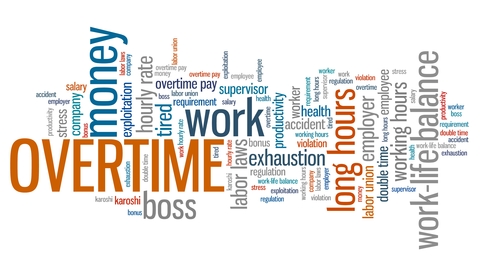 Under the federal Fair Labor Standards Act (FSLA), you are required to pay time and a half to most types of employees who work overtime. A final rule announced in May, which becomes effective on December 1, 2016, has drawn attention to federal overtime rules.
Under the federal Fair Labor Standards Act (FSLA), you are required to pay time and a half to most types of employees who work overtime. A final rule announced in May, which becomes effective on December 1, 2016, has drawn attention to federal overtime rules.
However, the overtime rules, including the new rule, are often misunderstood. Here are 10 misconceptions about these overtime pay rules — and the truth about them — to help employers stay compliant.
Myth #1: You have to pay overtime to all employees working more than 40 hours.
There is no overtime requirement for “exempt” workers. Generally, these are “white collar” employees who meet all of the following conditions:
- They are salaried, which means they receive a fixed, predetermined payment. However, under the final rule, up to 10% of the standard salary level can come from non-discretionary bonuses, incentive payments, and commissions paid at least quarterly.
- They are paid more than a threshold amount. Currently that amount is $455 per week ($23,660 per year). Starting December 1, 2016, it is $913 per week ($47,496 per year).
- They primarily perform executive, administrative, or professional duties.
Myth #2: There are situations in which double-time pay is required.
If you must pay overtime because an employee works more than 40 hours and is not exempt, federal law only requires time-and-a-half. Even if you have an employee working overtime on a holiday or weekend, there is no double-time requirement.
Myth #3: You must pay overtime if someone works nights.
Many jobs require employees to work nights. Assuming that the hours do not exceed 40 hours per week, no overtime is necessary for this work schedule.
Overtime pay rules apply to employees regardless of shifts or location. For example, hours worked at home must be taken into account if they are part of the employees’ workweek.
Myth #4: You must pay overtime if someone works weekends.
As in the case of evening or overnight schedules, working weekends does not automatically trigger overtime. Again, overtime is required only if an employee works more than 40 hours per week.
The same is true for holidays. Requiring an employee to work on Thanksgiving does not require overtime pay (although you aren’t prevented from paying more than the usual amount).
Myth #5: You can escape the overtime requirement by giving comp time.
An employer cannot avoid the need to pay overtime by giving a worker time off comparable to the overtime he or she worked. For example, if you have an employee who worked 45 hours in one week, you must pay overtime (cash wages) for the 5 additional hours. You cannot avoid the requirement to pay overtime by giving the worker 5 hours off the following week.
Myth #6: There’s a limit on the number of hours you can ask an employee to work.
There is no limit; you can set any workweek you want, as long as you can get workers to show up. For example, while most office jobs today are 35 hours per week, nothing in the law prevents you from requiring 50 hours of work per week. Of course, any hours over 40 trigger overtime (except for exempt employees).
The only exception to expanded hours: You can’t impose greater hours on workers who are under 16 years old.
Myth #7: You must count all of work-related time for overtime rules.
Meal breaks, whether paid or unpaid, aren’t counted as part of the 40-hour period if the employee is relieved of duties during that period. Also, activities before or after the workday are not counted. For example, the U.S. Supreme Court said that Amazon workers do not have to be paid for time they spend going through security upon leaving a warehouse. Workers argued that the 25 minutes was integral to their jobs; the Court said no to them.
Myth #8: Overtime is based only on salary.
The term “salary” for this purpose includes not only wages, but also commissions, nondiscretionary bonuses, and other nondiscretionary compensation earned during a 52-week period. It also includes payments for piece work.
For example, if a piece worker is owed overtime pay, you can pay one-and-half-times the piece rate for each piece completed during the excess hours. Or you can convert the piece work rate into an hourly rate.
For purposes of overtime pay rules, fringe benefits and other tax-free benefits are not counted. These include health insurance and retirement plan contributions.
Myth #9: Federal overtime rules trump state rules.
Some states have their own overtime pay rules. If they are more protective of workers, you must follow state law.
For example, California and some other states base overtime pay requirements on a daily rather than weekly basis. If a non-exempt employee in California works more than 8 hours a day, overtime pay is required, even if total hours in the workweek don’t exceed 40 hours.
Myth #10: Overtime pay can be waived by agreement.
Overtime pay is based on actual time worked in excess of 40 hours. You cannot avoid paying overtime simply by announcing to staff that you don’t want anyone to work more than 40 hours and you don’t want to pay overtime. If a non-exempt employee works more than 40 hours despite any agreement or announcement to the contrary, you must pay overtime.
Conclusion
The cost of overtime pay, especially under the new rule starting in December, can wreck a small business’ budget. Companies that need work done but can’t afford overtime pay will have to seek alternative solutions, including hiring part-timers, using temporary help, or turning to independent contractors where possible.
Employers can find more information about overtime pay from the Department of Labor’s Wage and Hour Division. You can also call 866-4USWAGE.


